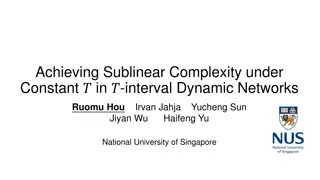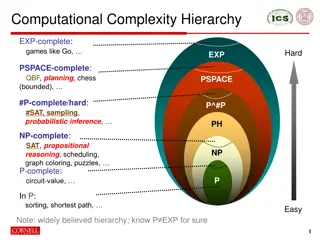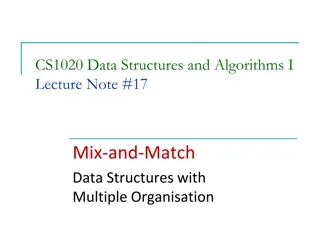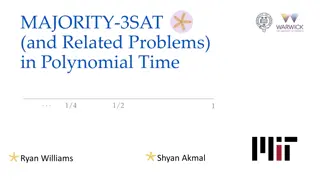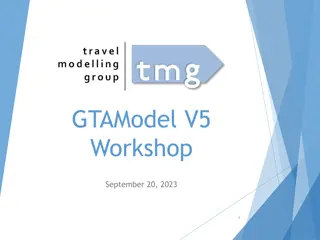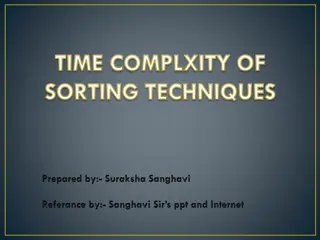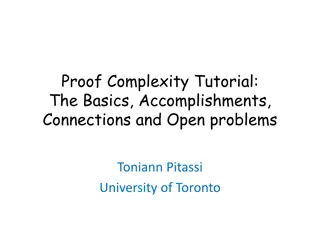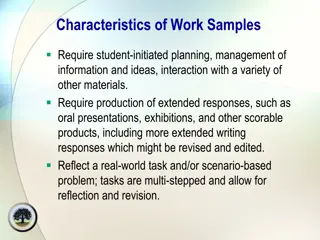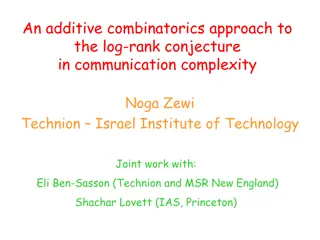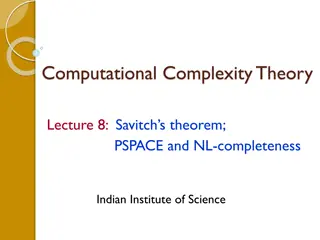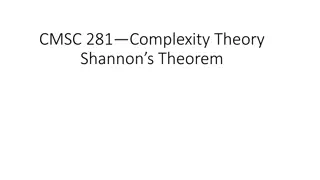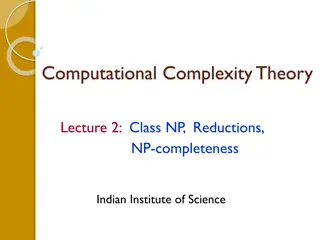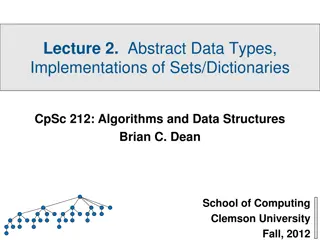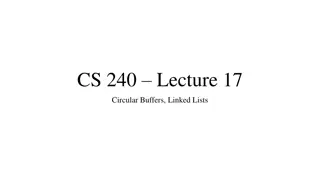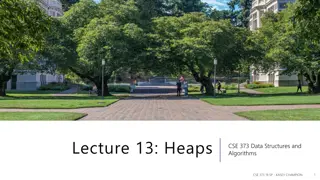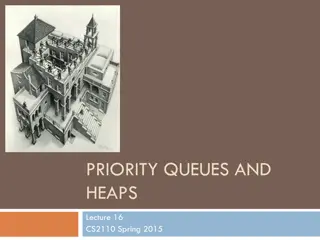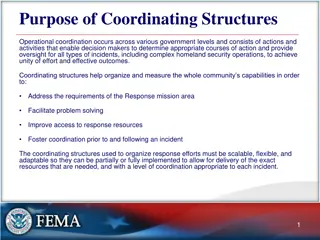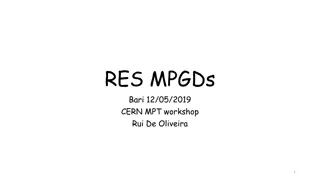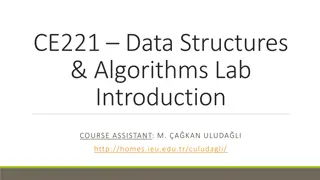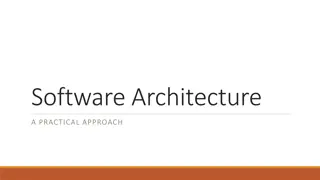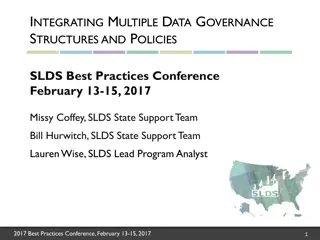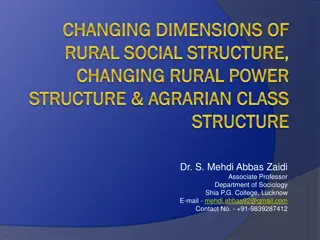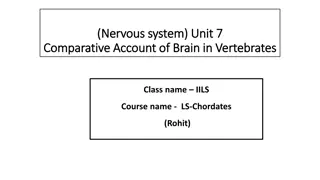Understanding Complexity in Data Structures
Introduction to logarithms, fractional exponents, and complexity analysis in algorithms. Exploring Big O notation to express algorithm complexity and examples demonstrating different time complexities. Learn about the importance of analyzing the efficiency of algorithms in data structures.
Download Presentation

Please find below an Image/Link to download the presentation.
The content on the website is provided AS IS for your information and personal use only. It may not be sold, licensed, or shared on other websites without obtaining consent from the author. Download presentation by click this link. If you encounter any issues during the download, it is possible that the publisher has removed the file from their server.
E N D
Presentation Transcript
CS 367 Introduction to Data Structures Lecture 6
Todays Agenda: Complexity of Computations Linked Lists
Whats this log business? Log is logarithm. Remember that an exponent tells us how many times a number is to be multiplied: 103means 10*10*10 A logarithm tells us what exponent is needed to produce a particular value. Hence log10(1000) = 3 since 103= 1000.
Fractional exponents (and logs) are allowed x = x0.5 This is because x * x = x, so x0.5* x0.5= x1= x Thus log10( x) = 0.5 * log10(x).
What base do we use? Usually base 2, but it doesn t really matter. Logs to different bases are related by a constant factor. Log2(x) is always 3.32 bigger than log10(x). Because 23.32 = 10
Many useful algorithms are n log(n) in complexity This is way better than an n2algorithm (because log(n) grows slowly as n grows).
Example: Giving a Toast Fill the glasses. Linear complexity 2. Raise glasses & give the toast Constant time 3. Clink glasses. Person 1 clinks with persons 2 to N Person 2 clinks with persons 3 to N Person N-1 clinks with person N 1.
Total number of clinks is (n-1)+(n-2)+ +1 +0. This sums to n*(n-1)/2 = n2/2 n/2. So this step is quadratic.
Big O Notation This is a notation that expresses the overall complexity of an algorithm. Only the highest-order term is used; constants, coefficients, and lower-order terms are discarded. O(1) is constant time. O(N) is linear time. O(N2) is quadratic time. O(2N) is exponential time.
The three functions: 4N2+3N+2, 300N2, N(N-2)/2 Are all O(N2).
Formal Definition A function T(N) is O(F(N)) if for some constant c and threshold n0, it is the case T(N) c F(N) for all N > n0
Example The function 3n2-n+3 is O(n2) with c =3 and n0= 3: n 3n2-n+3 3n2 1 2 3 4 5 5 13 27 47 73 3 12 27 48 75
Complexity in Java Code Basic Operations (assignment, arithmetic, comparison, etc.) : Constant time, O(1) List of statements: statement1; statement2; statementk; // k is independent of problem size
If each statement uses only basic operations, complexity is k*O(1) = O(1) Otherwise, complexity of the list is the maximum of the individual statements.
If-Then-Else if (cond) { sequence1of statements } else { sequence2of statements } Assume conditional requires O(Nc), then requires O(Nt) and else requires O(Ne).
Overall complexity is: O(Nc) + O(max(Nt, Ne)) = O(max(Nc, max(Nt, Ne))) = O(max(Nc,Nt, Ne))
Basic loops for (i = 0; i < M; i++) { sequence of statements } We have M iterations. If the body s complexity is O(Nb), the whole loop requires M*O(Nb) = O(M*Nb) (simplify O term if possible).
Nested Loops for (i = 0; i < M; i++) { for (j = 0; j < L; j++) { sequence of statements } We have M*L iterations. If the body s complexity is O(Nb), the whole loop requires M*L*O(Nb) = O(M*L*Nb) (simplify O term if possible).
Method calls Suppose f1(k) is O(1) (constant time): for (i = 0; i < N; i++) { f1(i); } Overall complexity is N*O(1) = O(N)
Suppose f2(k) is O(k) (linear time): for (i = 0; i < N; i++) { f2(N); } Overall complexity is N*O(N) = O(N2)
Suppose f2(k) is O(k) (linear time): for (i = 0; i < N; i++) { f2(i); } Unroll the loop. Complexity is: O(0)+O(1)+ +O(N-1) = O(0+1+ +N-1) = O(N*(N-1)/2) = O(N2)
Number Guessing Game Person 1 picks a number between 1 and N. Repeat until number is guessed: Person 2 guesses a number Person 1 answers "correct", "too high", or "too low problem size = N count : # guesses
Algorithm 1: Guess number = 1 Repeat If guess is incorrect, increment guess by 1 until correct Best case: 1 guess Worst case: N guesses Average case: N/2 guesses Complexity = O(N)
Algorithm 2: Guess number = N/2 Set step = N/4 Repeat If guess is too large, next guess = guess - step If guess is too small, next guess = guess + step step = step/2 (alternate rounding up/down) until correct
Best case: 1 guess Worst case: log2(N). So complexity is O(log N). Algorithm 2 is way better!
Returning N Papers to N Students problem size (N) = # students count # of "looks" at a paper What is the complexity of each algorithm below?
Algorithm 1: Call out each name, have student come forward & pick up paper best-case: O(N) worst-case: O(N) But, this algorithm cheats a bit! Why? Concurrency!
Algorithm 2: Hand pile to first student, student searches & takes own paper, then pass pile to next student. best-case: Each of N students hits at first search. This is N*O(1) = O(N). worst-case: N compares, then N-1 compares, etc. Time is O(N)+O(N-1)+ + O(1) = O(N2).
Algorithm 3: Sort the papers alphabetically, hand pile to first student who does a binary search, then pass pile to next student. Sort is O(N log N). Student 1 takes O(log N), Student 2 takes O(log (N-1)), Bounded by N*O(log n). Overall complexity is O(N log N).
Practice with analyzing complexity For each of the following methods, determine the complexity. Assume arrays A and B are each of size N (i.e., A.length = B.length = N)
method1 void method1(int[] A, int x, int y) { int temp = A[x]; A[x] = A[y]; A[y] = temp;} Constant time per call, thus O(1).
method2 void method2(int[] A, int s) { for (int i = s; i < A.length - 1; i++) if (A[i] > A[i+1]) method1(A, i, i+1); } Number of iterations is at most N. Each call is O(1) so overall complexity is O(N).
method3 void method3(int[] B) { for (int i = 0; i < B.length - 1; i++) method2(B, i); } Number of iterations is N-1. method2 does N-1 iterations, then N-2, etc. This totals to N2, so overall complexity is O(N2).
method4 void method4(int N) { int sum = 0, M = 1000; for (int i = N; i > 0; i--) for (int j = 0; j < M; j++) sum += j; } Since M is a constant, the entire inner loop takes a bounded amount of time; its complexity is O(1). Outer loop iterates N times, so overall complexity is O(N).
What if M is a parameter? void method4a(int N, int M) { int sum = 0; for (int i = N; i > 0; i--) for (int j = 0; j < M; j++) sum += j; } Now the entire inner loops takes O(M) time. The overall complexity is now O(N*M).
method5 public void method5(int N) { int tmp, arr[]; arr = new int[N]; for (int i = 0; i < N; i++) arr[i] = N - i; for (int i = 1; i < N; i++) { for (int j = 0; j < N - i; j++) { if (arr[j] > arr[j+1]) { tmp = arr[j]; arr[j] = arr[j+1]; arr[j+1] = tmp; }}}} What does this do?
Complexity of method5 Analyze in steps: 1. The call to new is O(1). 2. The first loop iterates N times; loop body is O(1), so loop is O(N). 3. The nested loop body iterates N-1 times, then N-2 times, , 1 time. Total is O(N2). Overall complexity is O(1)+O(N)+O(N2) = O(N2).
Complexity Caveats 1. Algorithms with the same complexity can differ when constants, coefficients and lower-order terms are considered. Which of these is better? 2N2+3N vs. 10N2
2. A better complexity means eventually an algorithm will be better. But for small to intermediate problem sizes, an inferior complexity may win out! Consider 100*N vs. N2/100. The quadratic complexity is better until N = 10,000.
Primitive vs. Reference Types Primitive types represent fundamental data values (integer, floating point, characters). Values are placed directly in memory. An int value in one word (4 bytes): 1234
Reference Types Data objects (created by new) are pointed to by a reference type. Int []
Assignment Assignment of a primitive type copies the actual value. A = 1234; A: 1234 B = A; B: 1234
Assignment of a reference type copies a pointer to an object. The object is not duplicated. A B B = A;
Assignment of Reference Types Leads to Sharing Given A B A[1] = 1; causes 1 A B
Use clone() to create a distinct copy of an Object B = A.clone(); creates: A B
But clone() makes a copy only of the object itself Objects accessed by references aren t copied. A B If we clone A we get
A B A Why isn t B copied too?
Consider: A B But you can create your own version of clone() if you wish!
Linked Lists Individual data items, called nodes, are linked together using references: Advantages: Easy to reorder nodes (by changing links). Easy to add extra nodes as needed.
Disadvantages: Each node needs a next field Moving forward is tedious (one node at a time). Moving backward is difficult or impossible.






